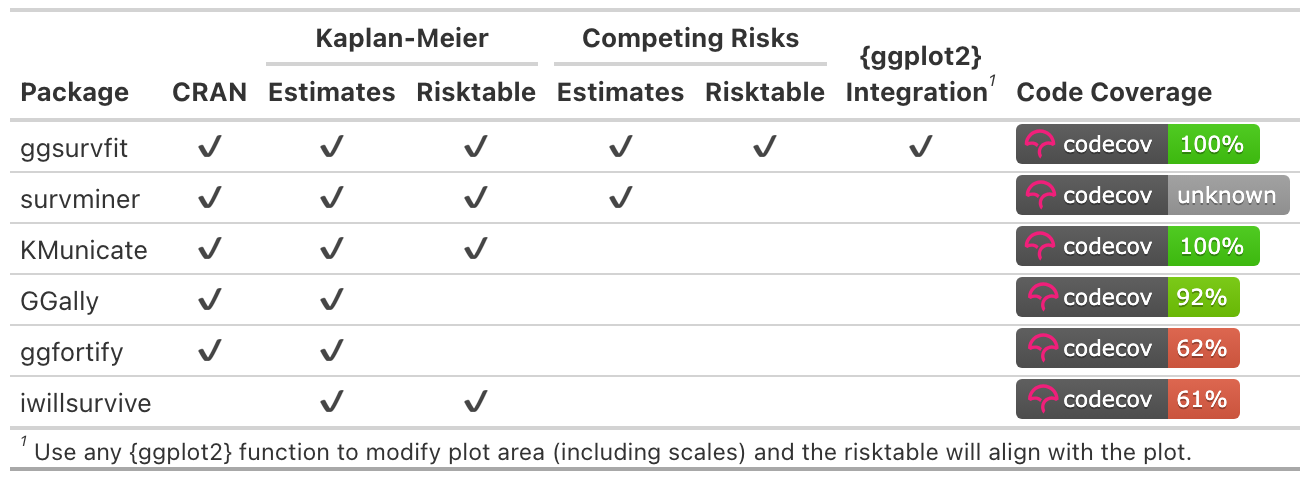

The ggsurvfit package eases the creation of
time-to-event (aka survival) summary figures with ggplot2. The concise
and modular code creates images that are ready for publication or
sharing. Competing risks cumulative incidence is also supported via
ggcuminc().
Use ggplot2 functions: Each
ggsurvfit add-on function
(e.g. add_confidence_interval(),
add_risktable(), etc.) is written as a proper ggplot2 ‘geom’,
meaning the package functions can be woven with ggplot2 functions
seamlessly. You don’t need to learn how to style the plot within the
ggsurvfit functions: rather, rely on the suite of ggplot2 functions you
already know.
Publishable Legends: Raw variable names do not
appear in the figure legend, e.g. "sex=Female".
Limitless Customization: You can modify the x-axis scales or any other plot feature and the risk table will still align with the plot.
Simple Saving: Save individual images easily
with ggplot2::ggsave().
Install ggsurvfit from CRAN with:
install.packages("ggsurvfit")You can install the development version from GitHub with:
# install.packages("devtools")
devtools::install_github("pharmaverse/ggsurvfit")Review the figure gallery for many more examples.
The code below constructs a basic {ggsurvfit} figure without customization.
library(ggsurvfit)
#> Loading required package: ggplot2
p <- survfit2(Surv(time, status) ~ surg, data = df_colon) |>
ggsurvfit(linewidth = 1) +
add_confidence_interval() +
add_risktable() +
add_quantile(y_value = 0.6, color = "gray50", linewidth = 0.75) +
scale_ggsurvfit()Any figure created with {ggsurvfit} can be customized using {ggplot2} functions.
p +
# limit plot to show 8 years and less
coord_cartesian(xlim = c(0, 8)) +
# update figure labels/titles
labs(
y = "Percentage Survival",
title = "Recurrence by Time From Surgery to Randomization",
)
survfit2() vs
survfit()Both functions have identical inputs, so why do we need
survfit2()? The survfit2() tracks the
environment from which the function was called, resulting in the
following benefits.
SEX=Female.survfit_p() and added
to figures.survfit(). However, by utilizing the calling environment we are
assured the correct elements are found, rather than crossing our fingers
that the search path contains the needed elements.The package also includes gems for those using the CDISC ADaM ADTTE v1.0 data model.
If columns "PARAM" or "PARAMCD" are present
in the data frame passed to survfit2(), their values will
be used to construct default labels in the ggsurvfit()
figure.
The event indicator in ADTTE data sets is named "CNSR"
and is coded in the opposite way the survival package expects
outcomes—1 = 'censored' and 0 = 'event'. This
difference creates an opportunity for errors to be introduced in an
analysis. The ggsurvfit package exports a function
called Surv_CNSR() to resolve this concern. The function
creates a survival object (e.g. survival::Surv()) that uses
CDISC ADaM ADTTE coding conventions as the default values. The function
can be used in ggsurvfit as well as any other package
that uses survival::Surv().
survfit(Surv_CNSR() ~ 1, adtte)
#> Call: survfit(formula = Surv_CNSR() ~ 1, data = adtte)
#>
#> n events median 0.95LCL 0.95UCL
#> [1,] 2199 755 3.2 3.1 3.56